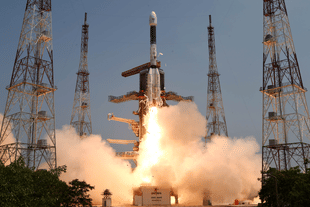Insta
ISRO Successfully Launches GSLV-F12 Mission To Deploy NVS-01 NavIC Navigation Satellite
Swarajya News Staff
May 29, 2023, 11:49 AM | Updated 11:59 AM IST
Save & read from anywhere!
Bookmark stories for easy access on any device or the Swarajya app.


The Indian Space Research Organisation (ISRO) on Monday (29 May) successfully accomplished its mission GSLV-F12/NVS-01.
The space agency launched the NVS-01 navigation satellite on board its geosynchronous satellite launch vehicle (GSLV) and deployed it in a geosynchronous transfer orbit.
The rocket lifted off from the second launch pad of the Satish Dhawan Space Centre-Sriharikota Range (SDSC-SHAR) at 10.42 am.
After a flight of about 19 minutes, the NVS-01 satellite was injected precisely into a geosynchronous transfer orbit.
"Subsequent orbit-raising manoeuvres will take NVS-01 into the intended Geosynchronous orbit," ISRO said in a tweet.
NVS-01 is the first of India's second-generation NavIC ('Navigation with Indian Constellation') satellites that accompany enhanced features.
The 2,232 kg navigation satellite features navigation payloads L1, L5, and S bands, including an indigenous atomic clock, a first of its kind.
According to ISRO, NavIC is a regional navigation satellite system established to meet the positioning, navigation and timing requirements of the nation. NavIC was previously known as the Indian Regional Navigation Satellite System (IRNSS).
The GSLV-F12 is India's fifteenth GSLV flight and the ninth with an indigenous cryogenic stage. It's also the sixth operational flight with such a stage.





